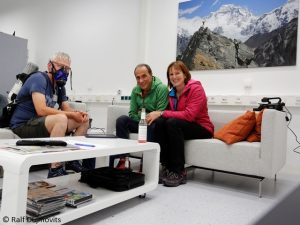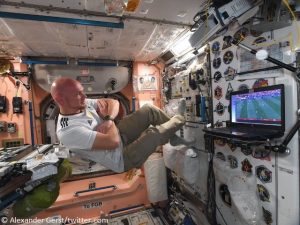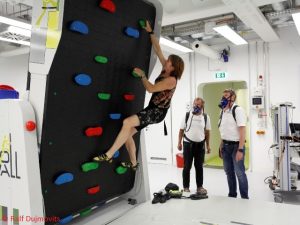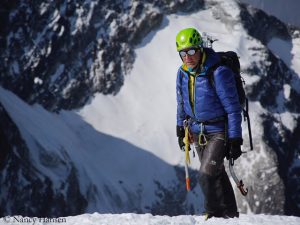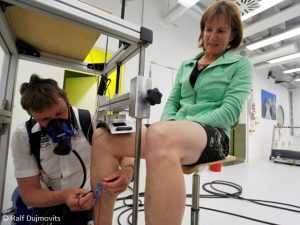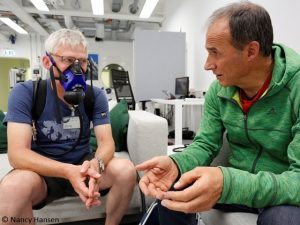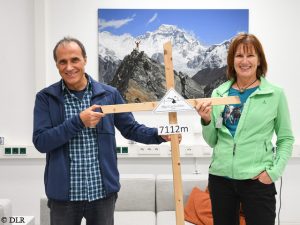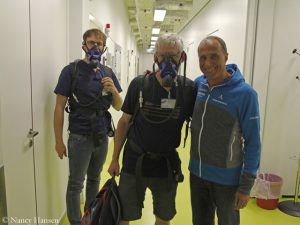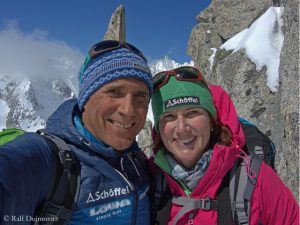“Hypoxia expedition” successfully completed
And suddenly the call came from space: “Here is Alex”. At first Ralf Dujmovits did not know who was talking at the other end of the telephone line: “Alex? Then I suddenly recognized the voice I had heard two days earlier during the broadcast of the rocket launch.” Alexander Gerst inquired from the International Space Station (ISS) about the condition of the German climber and his Canadian partner Nancy Hansen in the hypoxia chamber of the German Aerospace Center (DLR) in Cologne. “It sounded like he was sitting next door.” For a quarter of an hour, Ralf, the first and so far only German climber to have scaled all 14 eight-thousanders, spoke to “Astro Alex”, the first German astronaut to take command of the ISS. “He was very interested in our experience in the lab. That was great.” Of course, Nancy talked to Gerst too. For both climbers it was a “real highlight”, says the 49-year-old Canadian.
Underestimated strain
After five weeks in the 110 square meter hypoxia chamber, the door will open for Dujmovits and Hansen on Tuesday. Then the experiment will be over, in which it should be tested whether heart functions improve during a long stay in extremely thin air. Ralf and Nancy spent the last two weeks all day at a simulated altitude of 6.718 meters and slept at night at 6,490 meters. That left its mark. “You see us quite tired here,” says Ralf, when I visit them (with bottled oxygen) again last weekend. “I had expected otherwise. I was convinced that we would be a little tired at first, but after a while we would get so accustomed to the low-oxygen conditions that we would be able to cope well with it. I underestimated how exhausting the whole thing is.”
“A huge success”
One reason for this fatigue may be that – as it turned out with Ralf’s MRI – the blood in the veins of the brain has become extremely congested over time and the veins are swollen now. “I’ve never seen it so massive. At first glance, you’re not happy about this,” says Dr. Ulrich Limper, who leads the DLR study together with Prof. Jens Tank. “On the other hand, it is not a direct threat. We assume it will regress.” In four weeks, Dujmovits and Hansen will return to DLR for their first follow-up examination.
The scientists have collected a great deal of data that will now be evaluated. First results are expected to be available within six months. “It’s already a huge success for us,” says Limper. “The concept worked, we learned a lot. We are still cautious, but clinically it looks as if our hypothesis that certain heart functions improve under the influence of hypoxia could be confirmed. If we can substantiate that with the data, it would be great.” The study might even lead to new therapies for heart attack patients.
“Swollen” heart
Originally, it had been planned that, after an acclimatization phase, the two climbers would live day and night at a simulated altitude of 7,112 metres for two weeks. But the scientists had to change their arrangements. At that simulated height, Nancy’s pulmonary artery pressure – the pressure with which the oxygen-poor blood is pressed from the heart into the lungs – was significantly increased. The right half of her heart was therefore, to put it simply, “swollen”, Nancy’s values were at the limit. “From our point of view it would not have been successful to ‘chase’ her up”, says Limper. “Her condition probably would have gotten worse.” Therefore the simulated altitude was lowered to below 7,000 meters, at night even further down than during the day. “Nancy’s body coped with this. Her values slowly improved and towards the end approached those of Ralf again.”
Not much higher than 7,000 meters
According to Limper, it is assumed that in Nancy’s case it was a “normal reaction of a heart that is simply not yet accustomed to very high altitudes”. Ralf also told about health problems during his first expeditions, which no longer occured during his later projects. “There may be something like a long-term adaptation,” says the physician, adding that this has not yet been scientifically proven.
Nancy’s troubles made her and Ralf think. “It shouldn’t be a problem to tackle a seven-thousander where we spend the last night at 6,300 or 6,500 meters,” says Ralf. “But above that altitude, Nancy could suffer some damage to health. That’s what we’ve learned, and we’ll take that into account, of course.”
Constantly felt cold
During the time in the hypoxia chamber, both climbers have lost more than two kilograms of body weight each, primarily muscle mass. “The upper arms have become thinner,” says Ralfs, “and where normally the trousers are taut on the thighs, now everything flaps.” The climbers’ weight loss was lower than expected, says Ulrich Limper. “We attribute it to the fact that apart from hypoxia they had no stress factors as usual in the mountains: no cold, no pitching up the tent, no continuous physical strain. In the end, they moved very little.” Nancy and Ralf tried to stay reasonably fit on a treadmill, an ergometer and a mobile climbing wall. One of the surprising findings for the scientists was that Ralf was exhausted after 50 minutes on the ergometer, but did not sweat at all. It also seemed unusual that despite a room temperature of 24 degrees Celsius Nancy and Ralf felt so cold that they pulled two jackets over their T-shirts. So there are still a few question marks.
Into the sun!
Nancy and Ralf do not regret getting involved in the DLR experiment. On the contrary. “I would do it again,” says Nancy. “Scientifically I found the whole thing incredibly interesting. Of course, not every moment was fun, but overall it was an amazing experience that was pretty unique.” Also for Ralf “it was absolutely worth the effort”: “We leave the project healthy. And if we can make a contribution to the future development of a therapy for heart attack patients, then everything is perfect.”
And what are they looking forward to the most? “Sunshine,” Nancy answers quick like a shot. Ralf especially longs to see his family and friends again and is looking forward to sitting in the garden, running through the woods or cycling on his mountain bike for hours: “We had an incredibly committed team of scientists and doctors around us. We enjoyed it, it was exciting, and we learned a lot. But now it’s good that we’re coming home.”



